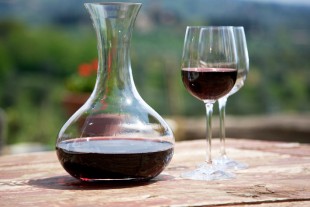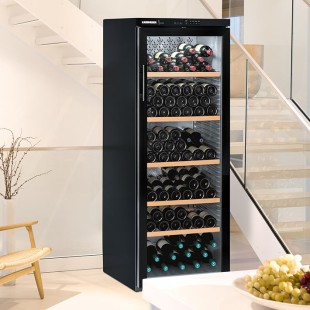How to store and enjoy fine wines

The right temperature is always a key factor, from the ripening of the grapes to the wines' production and storage, and through to the actual drinking of the wine.
From when the first young vine shoots appear, right through to bottling, vintners employ great expertise, devotion and diligence to ensure that only the very best drops fill the bottles. White wines are aged in barrels or special tanks for several months, at least, before they are ready for bottling. Red wines, on the other hand, can often take several years to age and, but after that, many will still not have developed their full flavour. When kept under optimum storage conditions, wines can age and further improve in the bottle.
Consistently cool – a dream climate for your wine
Whether it's winter or summer, wine needs a consistent temperature. Your precious bottles must be protected from UV light and all kinds of fragrances and odours. Even dry air and vibration can impair the quality of the wine. In Liebherr wine cabinets, fine wines are safe in the ideal storage conditions – to guarantee pure enjoyment.
Wine expertise from Liebherr
Winemaking is an exacting process that requires great care and professionalism. The film documents the processes involved and explains why a Liebherr wine fridge is the very best place to store your wine.
Let it rest and mature

Champagne undergoes secondary fermentation in the bottle
A hint of apple, floral notes of lilac, or a spicy bouquet reminiscent of cinnamon – wine connoisseurs use figurative descriptions to characterise the flavours and aromas found in the bouquet of a good wine. The grape variety, soil conditions and time of harvest all have a significant bearing on the wine's flavour, as does the extent and nature of the ageing processes. Delicate microbiological processes are responsible for the development of the flavour, many of which continue even after the filling stage. Wine connoisseurs refer to this as bottle ageing, and it is this process that often gives an outstanding taste to many fine wines.

During bottle ageing, wine should be stored in a place where it is protected against ambient influences.
Bottle ageing
During the bottle ageing stage several substances in the wine, notably acids, tannins and colorants, interact with one another, which breaks down any intensive woody notes and enables fruity flavours to further develop. Depending on the type of wine, its full flavour can take several years to develop. During this time, ambient influences such as airborne odours can distort the flavour of the wine, especially if it is stored on an open shelf in the kitchen. It is also important to realise that not every cellar makes an ideal wine cellar.

Natural corks retain their quality at humidity levels of over 50%.
The secret to successful bottle ageing
- Wine best develops its flavour in bottles that are stored at a constantly cool temperature of between 10°C and 12°C. Heat impairs the bottle ageing process and destroys fine flavour notes.
- Oxygen, which usually penetrates bottles through dried-out corks, also impairs the ageing process.
- A humidity level of over 50% keeps corks intact – and thus the bottles remain fully sealed, so that the wine is protected.
Liebherr wine cabinets create constant storage conditions, and therefore offer the optimum environment for wine that is being aged in the bottle.
Video

Creating the best possible storage conditions
A high-quality wine must have tranquil storage and controlled conditions as, only under such circumstances can complex aromas and flavour nuances develop in the bottle. Vibrations, odours and UV light all interfere with this development process. For example, UV light can trigger biochemical processes in the wine, which cause its taste and colour to deteriorate. Vibrations caused by footfall can also damage this sensitive product - if the wine molecules are disturbed in this way, the natural ageing process will be affected.
High-end technology for wine aficionados
Enjoy every sip
The moment of truth has arrived: your fine wine has been uncorked. Correctly stored, it will have developed its full flavour and, to be enjoyed at its best now, it will have been brought to just the right serving temperature before opening.

The flavour develops in the glass as the wine comes into contact with oxygen
What is the optimum serving temperature?
Red wine is served at a temperature of between 14°C and 18°C, and generally, the older the wine, the higher the temperature. Dry, crisp white wine should be chilled to 8°C. More mature and heavier bodied white wines develop their flavour up to 12°C, while sweet wines should be served at a slightly cooler temperature of between 6°C and 8°C. And to enjoy the fizz of champagne or sparkling wine on the palate, it should be chilled at least to 8°C. However, at the end of the day, it all comes down to personal taste, so why not experiment with different serving temperatures and find out what you enjoy the most?

Before being poured into a carafe, the wine should be cooled in the wine cabinet
Decant or aerate?
Not all wines benefit from lively pouring into a carafe. Red wines that have been stored for a long time should be carefully poured into a narrow decanter to separate the sediment from the wine. Contact with oxygen, which can oxidise and spoil older wines, should be minimised by using containers with as small a surface area as possible.
On the other hand, young red wines should be poured into a carafe, and enjoyed while still youthful and at their best. The contact with oxygen, which occurs by pouring them into a bulbous carafe, enables them to develop their flavour and become more harmonious.

The right glass emphasises the individual character of a wine
Which shaped glass for which wine?
The shape of the glass also has a huge impact on the enjoyment of the wine. Mature red wines unfurl their bouquet in large, bulbous glasses. Curvaceous glasses emphasise the fruity notes of young white wines. Champagne fizzes and sparkles most impressively in slender flutes. The fluted shape prevents the carbon dioxide from dissipating too quickly and enables the champagne to effervesce.
From optimum serving temperature to the choice of the right glass: wine is one of the oldest cultural commodities and drinking it should provide real pleasure. Liebherr wine cabinets ensure that wine can be both optimally stored and served at the perfect temperature – so you can have the right bottle ready for every occasion, and can truly enjoy your wine.

Vinidor range: the zoom view shows the interior temperature distribution.
Vinidor range
Vinidor appliances feature two or three wine safes, each of which can be independently set to between +5°C and +20°C. This offers you optimum flexibility with how you use them. For example, it's possible to simultaneously store red wine, white wine and champagne, all at their perfect serving temperatures. In addition, Vinidor wine cabinets also offer the ideal climate conditions for long-term wine storage and, with the varied sizes of the wine safes and adjustable temperature controls, these appliances are suitable for housing any wine collection.
Vinidor wine cabinet range
Wine storage cabinets: the zoom view shows the interior temperature distribution.
Wine storage cabinets
Wine storage cabinets create similar storage conditions to a wine cellar. A constant, electronically controlled temperature exists throughout the interior. This makes our wine storage cabinets ideal for long-term storage and wine ageing. Additionally, because their temperature can be adjusted between +5°C and +20°C, they can also be used to store a larger stock of wine bottles at the perfect serving temperature. The Liebherr GrandCru and Vinothek ranges offer wine storage cabinets in a variety of sizes and designs.
Multi temperature wine cabinet range
Multi-temperature wine cabinets: the zoom view shows the interior temperature distribution.
Multi-temperature wine cabinets
Multi-temperature wine cabinets in the Vinothek range are particularly suited for storing different types of wine at the ideal serving temperature. Special components create temperature stratification within the cabinets. Red wine can be stored at +18°C in the upper section; the lower section, with a temperature of +5°C, is perfect for storing sparkling wine or champagne; and the middle area is ideal for storing white wine at serving temperature.
Wine storage cabinet range






